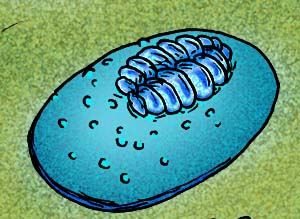Onega (animal)
| Onega | ||||||||
|---|---|---|---|---|---|---|---|---|

Onega stepanovi , life reconstruction |
||||||||
| Temporal occurrence | ||||||||
| Ediacarium | ||||||||
| 555 million years | ||||||||
| Locations | ||||||||
| Systematics | ||||||||
|
||||||||
| Scientific name | ||||||||
| Onega | ||||||||
| Fedonkin , 1976 | ||||||||
| Art | ||||||||
|
||||||||
Onega is an extinct Ediacarian genus ofuncertain classification that lived about 555 million years ago. The only known species of this genus is Onega stepanovi .
etymology
The generic name Onega is derived from the Onega Peninsula on the White Sea in northern Russia . The additional name stepanovi honors WA Stepanow, who discovered the first site with Ediacara biota on the summer coast (Letni Bereg) of the Onega Peninsula ( Arkhangelsk Oblast ) in 1972 as a student .
Initial description
Onega stepanovi was first described scientifically in 1976 by Mikhail Alexandrowitsch Fedonkin .
Occurrence
So far, fossil prints by Onega stepanovi are only known from Russia. The fossils come from the layers of the Vendian in Arkhangelsk Oblast ( Verkhovka Formation and Zimnie-Gory Formation ). They belong to the fossil communities ( English fossil assemblages ) Z 1 (I) and Z11 (XXII) from Zimnie Gory and SL1 (VII) from the Solsa river .
description
The rather small, flat fossils vary in length between 2.6 and 7 millimeters and in width between 1.6 and 4.7 millimeters. They are oval in shape. In the center there is a structured area made up of isomers , which is surrounded by an undivided edge. The surface of the rim is covered by small tubercles.
Taxonomy
Onega was originally described by Michail Fedonkin as an organism of problematic classification, which, due to a certain similarity with primitive trilobites of the Cambrian, possibly formed an arthropod trunk group together with Praecambridium , Vendia , and Vendomia .
In 1985 Fedonkin established the Proarticulata tribe , to which he added the following taxa:
Nevertheless, he did not rule out the possibility that Onega was also related to other sub-Cambrian arthropods such as Skania .
Ivantsov (2007) also suggested that Onega be included in the stem of the Proarticulata, since the symmetry, which is characteristic of Proarticulata and offset by sliding reflection , can be seen in very well-preserved new finds .
Fossil Conservation
All fossil finds are negative prints on the underside of fine-grain sandstone banks. They occur together with the so-called elephant skin and tubercle structure, which are diagnostic for microbe mats .
Socialization
The following taxa occur on the same layer surface together with Onega :
- Albumares
- Andiva
- Anfesta
- Archaeaspinus
- Charniodiscus
- Cyclomedusa
- Dickinsonia
- Ediacaria
- Eoporpita
- Kimberella
- Parvancorina
- Tribrachidium
- Vendia
- Yorgia .
Individual evidence
- ↑ a b Keller, BM, Menner, VV, Stepanov, VA and Chumakov, NM: Новые находки Metazoa в вендомии Руссой платформы " [New Finds of Metazoa in the Vendomii of the Russian Platform In] (in Russian) . Akad In ] (in Russian) Nauk SSSR, Ser. Geol. Volume 12 , 1974, p. 130-134 .
- ↑ BM Keller and MA Fedonkin: Новые находки окаменелостей в валдайской серии докембрия по р. Сюзьме [New Records of Fossils in the Valdaian Group of the Precambrian on the Syuz'ma River] (in Russian) . In: Izv. Akad. Nauk SSSR, Ser. Geol. Band 3 , 1976, p. 38-44 .
- ↑ DV Grazhdankin: The Structure and Sedimentation Conditions in the Vendian assemblage in the Southeastern White Sea . In: Stratigraphy and Geological Correlation . tape 11 (4) , 2003, pp. 313-331 .
- ↑ DV Grazhdankin: Patterns of distribution in the Ediacaran biotas: facies versus biogeography and evolution . In: Paleobiology . tape 30 (2) , 2004, pp. 203-221 , doi : 10.1666 / 0094-8373 (2004) 030 <0203: PODITE> 2.0.CO; 2 .
- ↑ a b c Ivantsov, AY: Small Vendian transversely Articulated fossils . In: Paleontological Journal . tape 41 (2) , 2007, pp. 113 , doi : 10.1134 / S0031030107020013 .
- ↑ a b Zakrakevskaya, Maria: Paleoecological reconstruction of the Ediacaran benthic macroscopic communities of the White Sea (Russia) . In: Palaeogeography, Palaeoclimatology, Palaeoecology . tape 410 , 2014, p. 27-38 .
- ^ A b M. A. Fedonkin: Systematic Description of Vendian Metazoa . In: Vendian System: Historical-Geological and Paleontological Foundation . Vol. 1: Paleontology. Nauka, Moscow 1985, p. 70-106 .
- ↑ Stefan Hengtson, Mikhail A. Fedonkin; and Jere H. Lipps: The Major Biotas of Proterozoic to Early Cambrian Multicellular Organisms . Ed .: J. William Schopf and Cornelis Klein. Proterozoic Biosphere. Cambridge University Press, 1992, pp. 433-435 .
- ↑ Gehling, JG: Microbial mats in terminal Proterozoic siliciclastics: Ediacaran death masks . In: PALAIOS . tape 14 (1) , 1999, pp. 40-57 , doi : 10.2307 / 3515360 .